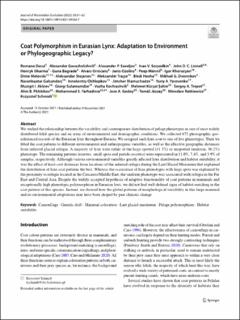| dc.contributor.author | Darul, Romane | |
| dc.contributor.author | Gavashelishvili, Alexander | |
| dc.contributor.author | Saveljev, Alexander P. | |
| dc.contributor.author | Seryodkin, Ivan V. | |
| dc.contributor.author | Linnell, John Durrus | |
| dc.contributor.author | Okarma, Henryk | |
| dc.contributor.author | Bagrade, Guna | |
| dc.contributor.author | Ornicans, Aivars | |
| dc.contributor.author | Ozolins, Janis | |
| dc.contributor.author | Männil, Peep | |
| dc.contributor.author | Khorozyan, Igor | |
| dc.contributor.author | Melovski, Dime | |
| dc.contributor.author | Stojanov, Aleksandar | |
| dc.contributor.author | Trajçe, Aleksandër | |
| dc.contributor.author | Hoxha, Bledi | |
| dc.contributor.author | Dvornikov, Mikhail G. | |
| dc.contributor.author | Galsandorj, Naranbaatar | |
| dc.contributor.author | Okhlopkov, Innokentiy | |
| dc.contributor.author | Mamuchadze, Jimsher | |
| dc.contributor.author | Yarovenko, Yuriy A. | |
| dc.contributor.author | Akkiev, Muzigit I. | |
| dc.contributor.author | Sulamanidze, Giorgi | |
| dc.contributor.author | Kochiashvili, Vazha | |
| dc.contributor.author | Şahin, Mehmet Kürşat | |
| dc.contributor.author | Trepet, Sergey A. | |
| dc.contributor.author | Pkhitikov, Alim B. | |
| dc.contributor.author | Farhadinia, Mohammad S. | |
| dc.contributor.author | Godoy, Jose A. | |
| dc.contributor.author | Jászay, Tomáš | |
| dc.contributor.author | Ratkiewicz, Mirosław | |
| dc.contributor.author | Schmidt, Krzysztof | |
| dc.date.accessioned | 2022-06-20T12:10:43Z | |
| dc.date.available | 2022-06-20T12:10:43Z | |
| dc.date.created | 2021-11-22T08:59:34Z | |
| dc.date.issued | 2021 | |
| dc.identifier.citation | Journal of mammalian evolution. 2021, . | en_US |
| dc.identifier.issn | 1064-7554 | |
| dc.identifier.uri | https://hdl.handle.net/11250/2999616 | |
| dc.description.abstract | We studied the relationship between the variability and contemporary distribution of pelage phenotypes in one of most widely distributed felid species and an array of environmental and demographic conditions. We collected 672 photographic georeferenced records of the Eurasian lynx throughout Eurasia. We assigned each lynx coat to one of five phenotypes. Then we fitted the coat patterns to different environmental and anthropogenic variables, as well as the effective geographic distances from inferred glacial refugia. A majority of lynx were either of the large spotted (41.5%) or unspotted (uniform, 36.2%) phenotype. The remaining patterns (rosettes, small spots and pseudo-rosettes) were represented in 11.0%, 7.4%, and 3.9% of samples, respectively. Although various environmental variables greatly affected lynx distribution and habitat suitability, it was the effect of least-cost distances from locations of the inferred refugia during the Last Glacial Maximum that explained the distribution of lynx coat patterns the best. Whereas the occurrence of lynx phenotypes with large spots was explained by the proximity to refugia located in the Caucasus/Middle East, the uniform phenotype was associated with refugia in the Far East and Central Asia. Despite the widely accepted hypothesis of adaptive functionality of coat patterns in mammals and exceptionally high phenotypic polymorphism in Eurasian lynx, we did not find well-defined signs of habitat matching in the coat pattern of this species. Instead, we showed how the global patterns of morphological variability in this large mammal and its environmental adaptations may have been shaped by past climatic change. | en_US |
| dc.language.iso | eng | en_US |
| dc.relation.uri | https://link.springer.com/article/10.1007%2Fs10914-021-09580-7 | |
| dc.rights | Navngivelse 4.0 Internasjonal | * |
| dc.rights.uri | http://creativecommons.org/licenses/by/4.0/deed.no | * |
| dc.subject | Camouflage | en_US |
| dc.subject | Genetic drift | en_US |
| dc.subject | Mammal coloration | en_US |
| dc.subject | Last glacial maximum | en_US |
| dc.subject | Pelage polymorphism | en_US |
| dc.subject | Habitat suitability | en_US |
| dc.title | Coat Polymorphism in Eurasian Lynx: Adaptation to Environment or Phylogeographic Legacy? | en_US |
| dc.type | Peer reviewed | en_US |
| dc.type | Journal article | en_US |
| dc.description.version | publishedVersion | en_US |
| dc.subject.nsi | VDP::Zoologiske og botaniske fag: 480 | en_US |
| dc.subject.nsi | VDP::Zoology and botany: 480 | en_US |
| dc.source.pagenumber | 51-62 | en_US |
| dc.source.volume | 29 | en_US |
| dc.source.journal | Journal of mammalian evolution | en_US |
| dc.identifier.doi | 10.1007/s10914-021-09580-7 | |
| dc.identifier.cristin | 1957075 | |
| dc.relation.project | Andre: National Science Center, Poland, 2014/15/B/NZ8/00212 | en_US |
| dc.relation.project | EC/FP7/Marie Curie Actions grant, contract No. PIRSESGA-2009-247652 | en_US |
| dc.relation.project | Norges forskningsråd: 251112 | en_US |
| cristin.ispublished | true | |
| cristin.fulltext | original | |
| cristin.qualitycode | 1 | |

